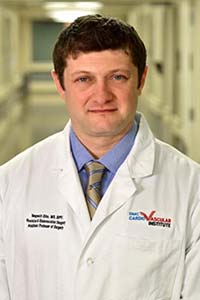New Non-Surgical Technique at Detroit Medical Center Benefits Dialysis Patients
Mar 27, 2019DETROIT — Vascular surgeon Yevgeniy Rits is the first physician in Michigan to perform a new endovascular procedure for patients with chronic kidney disease.
 The procedure, performed at DMC Harper University Hospital, allows vascular surgeons to create a dialysis access by connecting an artery and a vein using a minimally invasive technique developed by WavelinQ called endovascular AVF or endoAVF. Efficient access to the bloodstream is critical for dialysis treatment. Dr. Rits, Assistant Professor of Surgery and Director of Dialysis Access Center at DMC Harper University Hospital, says the Becton Dickson WavelinQ system is an innovative new device that makes this method for creating vascular access for dialysis possible. The procedure involves inserting two magnetic catheters into an adjacent vein and artery in the patients forearm. The system is then activated to create a minimally invasive connection, or fistula, that can be used for dialysis treatment. The system was recently approved by the Food and Drug Administration.
The procedure, performed at DMC Harper University Hospital, allows vascular surgeons to create a dialysis access by connecting an artery and a vein using a minimally invasive technique developed by WavelinQ called endovascular AVF or endoAVF. Efficient access to the bloodstream is critical for dialysis treatment. Dr. Rits, Assistant Professor of Surgery and Director of Dialysis Access Center at DMC Harper University Hospital, says the Becton Dickson WavelinQ system is an innovative new device that makes this method for creating vascular access for dialysis possible. The procedure involves inserting two magnetic catheters into an adjacent vein and artery in the patients forearm. The system is then activated to create a minimally invasive connection, or fistula, that can be used for dialysis treatment. The system was recently approved by the Food and Drug Administration.
Chronic kidney disease affects millions of people world-wide. The final stage of kidney disease is called End-Stage Renal Disease (ESRD). There are 440,000 patients in the U.S alone with ESRD. When a patient has ESRD, their kidneys can no longer keep up with the body’s need to remove extra waste and water. In fact, once kidney function goes below 10-15 percent of normal function, dialysis treatments or a kidney transplant are necessary to sustain life. ESRD patients require dialysis to stay alive because their kidney function is too low to remove the necessary fluid and toxins.
Clinicians rely on access to the bloodstream in order to administer dialysis, and most commonly, this is done by creating an arteriovenous (AVF) fistula between an artery and vein. That type of fistula is typically placed in a patient’s arm.
“These patients depend on dialysis access as their lifeline for treatment,” said Dr. Rits. “This new procedure does not require open surgery to create the access, which had been the standard of care for over 50 years. This will cut down on patients who are normally deemed ‘high risk.’”
In addition, the endovascular AVF approach lessens the trauma to a patient’s blood vessels and creates the access in a different area in the forearm, near the ulnar artery and ulnar vein.
“The new technique also gives patients the best chance to use their natural blood vessels instead of a more complicated, surgical procedure using a graft,” added Dr. Rits. “People living with ESRD are an underserved patient population with very limited treatment options available to them.”

